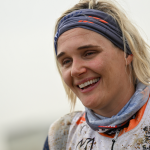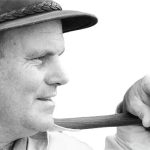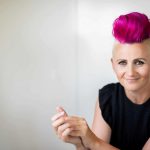Author: Joey Evans
How Joey Evans Went From Paraplegic To Dakar and In October 2007, a devastating off-road bike accident left Joey Evans paralysed from the chest down. Ten years later, he achieved his dream of finishing the 2017 Dakar Rally on a motorbike. This is the story of the power of grit, determination, and following crazy, audacious […]
How Joey Evans Went From Paraplegic To Dakar and In October 2007, a devastating off-road bike accident left Joey Evans paralysed from the chest down.
Ten years later, he achieved his dream of finishing the 2017 Dakar Rally on a motorbike.
This is the story of the power of grit, determination, and following crazy, audacious goals.
When things are really tough and there seems no hope for the future, it’s sometimes just chapter one of a really cool story, and the ending is entirely up to you.
This is how Joey Evans views the accident that left him a paraplegic.
It’s also the mindset that not only got him out of a wheelchair, but helped him to become the tenth South African to finish the Dakar Rally.
Here are the six lessons in grit, determination and resilience that he’s learnt along his journey.
1. The future is an unknown; you need to do your best anyway
If we knew with absolute certainty that we would achieve our goals, following daily routines — particularly tough ones — would be a lot easier.
But, there is no certainty. You need to put in the work now for the promise, not the certainty, of an outcome.
Joey Evans is an extreme example of this strategy in action. In October 2007, with two races left in a regional off-road racing championship, and his sights set on a win,
Joey crashed his bike at the start of the race and was ridden over by almost the entire field of racers.
Teeth shattered and his back broken, Joey woke up spitting out his own teeth and unable to feel his legs.
“Up until that point, I didn’t want to crash because of the time it would take away from the racing circuit while my bones healed,” he says.
“The idea that I would never walk again, let alone race, was crushing.”
The first two doctors agreed that Joey would never walk again.
He thirdly wanted to fuse his back to take pressure off his spinal cord. But he also offered some hope — he had no idea whether the husband and father of four daughters would walk again and ride Paraplegic To Dakar.
Joey had an incomplete spinal cord injury, which meant the spinal cord was compressed, but not severed.
In theory, this meant that when the swelling eventually went down, and with enough physical therapy, Joey might, potentially, one day get out of his wheelchair.
“I had to make the decision every day to get up and go through incredible pain and heartache on the off chance that I might get better,” he recalls. “There were no guarantees.
It was one of the toughest things I’ve ever faced, mentally. All you can do is keep going and do your best. But, you don’t know if your best is good enough.
No one can tell you.”
The most important step anyone can take is the next one. Day after day, Joey stuck to his routine.
How did he get through it? According to him, the secret to achieving your goals is to stay positive.
“It doesn’t matter what you’re trying to achieve or where the goals posts are, there will always be some days that are harder than others.
That’s when staying positive and having a strong support system are so important. No one can achieve great things alone.
“You need people who believe in you, and can pick you up when necessary.
I had my family, and I’m a naturally positive person.
Even so, there were some days when I just needed to let myself cry, get it out of my system, and then pick myself back up and press on.”
Practising the art of gratitude helped Joey to keep going when things got really tough. “I had so much, and I constantly reminded myself of that.
“Even in a wheelchair I could do a lot. I didn’t want my wife and kids to suffer. You can let yourself go sometimes; it’s what you do next that’s important. Gratitude is a muscle.
The more you work it, the stronger it becomes, and the higher the probability that you will be able to pick yourself back up and keep going.”
Joey didn’t let himself quit and three months later, he was walking again.
He’ll never be the way he was pre-accident. He doesn’t have 100% feeling in his legs, he drags his feet, and he will always have bowel control issues, but he got out of the chair because he kept following a rehab routine that held the promise of a better future.
“In the beginning, there were so many things that horrified me.
My occupational therapist pulled me out of that headspace by telling me that I shouldn’t let what other people think determine my life.
I needed to get busy living — and that’s what I did.”
2. It’s not how often you fall, but how often you get back up that counts
Two years later, Joey was back on a bike.
At first it was a disaster — he had no core muscles, and if the bike fell he couldn’t get back up.
But he pushed himself, and four years after the accident he was back on a race track. But, he was completely different.
“I’m competitive, and I had a natural talent for sports. I was captain of the team, I did ultra marathons, I wanted to win.
Now I was hacking it out at the back and getting lapped by every other racer on the track.”
It’s during times of adversity that we really realise what we’re made of. Talent got Joey to where he was before his accident.
Resilience got him to where he is today — and it was a humbling experience.
“When the mind and body don’t align, you end up going on a self-reflective journey.
I was working harder than I ever had before, and I just kept falling over and getting lapped. I wanted to scream, ‘this isn’t me, I’m not this guy,’ except that I was.
“There are physical and mental elements to recovery, and in both cases, it’s about getting back up when you fall. Getting out of the chair,
I learnt to recognise when dark days were closing in so that I could pull myself back out. Physically, I learnt that I was only competing with myself.
I had to learn to stop worrying about the rest of the field and concentrate on myself and achieving my goals.
“I had so much to be grateful for, and competing against myself was part of that.
How much better can I be? I can’t beat anyone here — but I can refuse to quit.
I can get to the finish. That realisation right there is what got me through the Dakar.
“That first race, I just wanted to complete one lap.
I had friends shadowing me, and at the end they had to help me lift my bike up, so I wasn’t alone.
I did as much as I could, and then needed to accept help, and that was also a valuable lesson — nothing we achieve in life is a solo accomplishment. There’s always a team. Appreciate them.”
It wasn’t only Joey’s friends who kept him going. By the time he reached the Dakar, his team was instrumental in his success.
“My mechanic worked on my bike late at night because I was slow, and they couldn’t sleep properly during the day because they had to move to the next location.
“Another South African, Walter Terblanche, who was out by stage four came back to the race to support me.
Each night he’d lead me back to our camp.
I was able to fall off my bike and into bed, and only worry about riding because of my team.
“None of this would have been possible without them. Never forget that. Teams are the root of any achievement.”
3. Don’t play the blame game, and endure with a smile
“Two of the biggest lessons I’ve learnt are the importance of enduring with a smile, and seeing people for who they are,” says Joey.
Unfortunately, it often takes a humbling experience to learn these lessons, even though they’re vital to happiness and success.
“It’s very easy to go down a black hole when you’ve been through something like this,” he says. “And you’d be justified.
But, your burden shouldn’t be everyone else’s.
Love and support are one thing, but no one deserves constant negativity in their lives.
“My wife had to teach me this. I was in a bad place and getting snappy with my kids, and she pulled me back in.
They didn’t deserve that.
I realised I could choose to have the most important people in my life, or drive them away. “It’s an empowering choice that allows you to take control back.
“You might not be able to change the circumstances, but you can control how you react to them. I chose to race.
I could blame all the other riders who rode over my back, but what would that achieve? It wouldn’t change anything. How I learnt to cope with my new reality was all that mattered.”
Joey’s next challenge was dealing with the way people treated him differently.
“I went from an ultra-competitive racer who was used to winning to a dude in a wheelchair who people looked at strangely. People would meet us in public and speak to my wife, not me.
“It was surreal, and gave me a new perspective on how we treat people. We all make assumptions based on external factors, and it’s extremely limiting.
Open your eyes. Put yourself in someone else’s shoes.
That perspective will shift your world view, and make you open to new ideas and experiences.”
4. Start with a huge vision, then work out how you’re going to do it
When Joey woke up in hospital, one of his first thoughts was ‘imagine I could come back from this to finish the Dakar.’
Racing the world’s toughest off-road race had always been a dream. Now it became Joey’s guiding star.
He didn’t share his dream with anyone but his wife, but it’s what got him out of his wheelchair, and back onto a bike, racing again.
Let’s outline what he was actually dreaming about. The Dakar spans almost 9 000 kilometres over 13 days across some of the world’s toughest terrain.
Before Joey completed it, only nine other South Africans had ever finished the Dakar.
Each year, around 150 bikes start the race, and only two-thirds finish.
For first timers, the chances of finishing are 30%. Bikers drop out every single stage (day), sometimes with severe injuries.
Joey knew he needed something huge and crazy to keep him going.
“I believe you need to put it out there, into the universe, and then go all out to make it happen.
Anything is possible. It is only our own minds that limit us.
“I saw myself crossing the finishing line and crossing the ramp.
I envisioned the end, and that created a mindset that it had already happened. I just had to follow the path that would get me there.”
But that path was studded with setbacks.
To qualify for the Dakar you need to submit a CV with a set number of long-distance rallies and endurance races, at least one of which needs to be on the international circuit.
To meet the criteria and to get ready for the race, by 2013 Joey was competing in 500km and 1 000km endurance races.
It had taken him years to get back up that level, and then, in 2014, he hit a cow in KwaZulu Natal and ended up back in hospital — this time with broken ribs and a shattered arm.
The recovery would take him six months.
“It was devastating. When I woke up and could feel my legs, I knew I could handle anything else, but I still questioned everything I was doing.
What was I putting my family through? And for what?
So many people had been horrified when I started racing again, asking my wife why she let me do it.
“Her answer was that she needed to let me be me.
But I also knew that I couldn’t sacrifice my marriage for the Dakar, like so many other riders.
A dream like this impacts everyone around you. After I recovered I went on a solo ride to the Cape to clear my head, and understand my motivations.
“We all need reality checks along our journeys. Circumstances change.
You can’t blindly pursue goals without understanding the consequences.”
The end result of Joey’s contemplation was a recommitment to Dakar.
“I realised that I was half way through life, and I still didn’t know what I wanted to be when I got big.
“I knew this would be a big regret if I didn’t do it. It was so clear to me.
This was my dream and goal. It didn’t need to make sense to everyone else — It needed to make sense to me.
I realised I could go a few more rounds, and that I wasn’t done yet.”
A year later, Joey was back at the Amageza, a 5 000km rally through Botswana and the Northern Cape.
He followed that up with his international race in Morocco, sent his entry in to the Dakar — and was accepted. Now he just needed the R1,1 million fee to compete.
5. Don’t let yourself off the hook
There are two ways to compete in the Dakar. You can be a professional racer and a paid member of a team, or you can enter as a privateer and pay your own way.
It’s expensive and incredibly hard work.
You buy your way onto a team (in Joey’s case, a Dutch team), but you don’t enjoy the perks of being on a professional team.
None of that mattered if Joey couldn’t raise R1,1 million though.
“If you give people a cause and say ‘join me’, they’ll do it.
But someone has to start. I had to say, ‘this is my dream, and I’m going’, and then sponsors came on board.
If you share your vision, it’s incredible how people will support you.”
Joey didn’t have a large corporate sponsor.
He cobbled R1,1 million together from donations ranging from R50 to R100 000. Every sponsor’s name was on his bike — a homage to how everything we achieve in life is ultimately a group effort.
“The real challenge was sharing my story. Until that point, only people close to me knew what I’d been through, but now I had to be vulnerable and let other people in.
My story was covered far and wide, and I had many eyes on me.
“You can crumble under that kind of pressure, or use it to drive you — again, it comes down to a choice.
It taught me there are so many different forms of courage.
“But it also kept me going. From day one I didn’t think I could continue.
“On day four I tore my ligament. On day 12 a car drove over my bike and destroyed it.
In each of those cases I could have bowed out, and no one would have blamed me.
But I didn’t. By the end of day three I was completely fatigued and physically broken. I thought I’d be coming home.
“There were ten days left and I was already at my limit.
That’s when I realised that I couldn’t think about the whole race; if I did I’d be out.
So, I concentrated on the next checkpoint instead, and when that got too much, I focused on the next kilometre, or even the next metre.
With any huge goal, you need to break it down or it’s just too big.
“When all you’ve had is four hours of sleep and you need to do 800kms in extreme conditions, your mind and body tells you it’s not possible — because it’s not.
So, you can’t focus on that. Instead, you tell yourself you’re just aiming for the first checkpoint.
Then the second, then lunch. And each of those steps by themselves is manageable. That’s how you achieve the impossible.”
6. If you want something badly enough, you’ll always make a plan
To really understand what it took for Joey to keep going, we need to understand what the Dakar looked like for him.
By day three he had realised that he was way over his head.
On day four, two of his team mates burnt out their motors in high altitudes on the dunes, and were out of the race, and Joey tore a ligament on the side of his knee.
He had five hours of sleep that night, and, physically and mentally broken, accepted that he was out.
But, instead of staying in bed, he got up, took an anti-inflammatory, wrapped up his knee, and got on his bike.
Why? What propelled him forward, when his whole body was telling him he was done?
“Resilience becomes a habit.
If you keep getting back up for long enough, it becomes your body and mind’s default setting, even in the face of insurmountable challenges.
I’d spent ten years getting ready for the Dakar, building up my physical strength.
“What I didn’t realise until I got there was that I’d also built up my mental strength.
I’d conditioned myself to keep going, no matter what.” Despite torn ligaments, the Dakar wasn’t done with Joey yet.
One of the benefits of limited feeling in his legs was that he couldn’t feel the full extent of his injury.
But, the following day threw a new mental curveball. Another South African had a high-speed crash, and was med-evaced out of the race with a leg broken in nine places.
Joey was now the last South African left in the field. And then a reprieve: Day six was cancelled due to flooding.
Racers still needed to reach the next checkpoint, but it was easier than racing.
A rest day followed, giving Joey the boost he needed to keep going.
“Days eight and nine were the marathon stage, where you sleep out at an overnight location and do all your own bike maintenance.
“At the end of day nine, a landslide blocked our route to the bivouac, and we now had a 350 km detour ahead of us, and it was already 9:30pm.
We could have stopped then and there, but even after having spent 16 hours on our bikes, my teammate and I decided to push through.
“We arrived at 3:20am the following morning, slept for two hours, and got back on our bikes for day ten.
By day 11 I was so tired I crashed twice and buckled my tyre.
I could have walked away and no one would have blamed me. But I’d conditioned myself not to let myself off the hook.
“I beat the wheel with a rock until it was reasonably straight and straightened my handle bars. I was expecting to ride through the night again at the pace I was going. My stars were aligned though.
There are only two designated service points in the entire race — and one was 10kms down the road.
“My team was there, and they fitted a new wheel for me. It was a gift. And if I’d given up after the second crash, I would have missed it.
By the end of that day my clutch went and I pushed my bike across the finish line at 11pm that night.
“On day 12 I was stone last, but still in the race. And then a car drove up behind me in a gully, and I had to dive off my bike to avoid getting hit.
I was okay; my bike was crushed My fuel tank was cracked and I’d lost most of my fuel, my exhaust was broken, my handle bars were skew. My race was done.
“There were no other bikes behind me who would come past and help.
All I could do was wait for the sweeper, a truck that comes through at the end of each stage, sweeping up the broken bikes and their riders.
“And then old habits kicked in. I wasn’t going to just sit there and wait.
“I had enough fuel for 20kms, and when that was done I’d push. Every metre was another metre I’d covered in the Dakar.”
Joey made his bike rideable and set off — which was why he found the KTM abandoned on the side of the route.
The rider and been evaced, and the bike was abandoned.
“The rules prohibit you taking someone else’s bike — but they don’t stop you from stripping it,” he says.
“I was looking for a way to keep going. This bike’s parts were it.”
With the help of three Argentinians who came past, Joey stripped the bike and got back in the race.
He later boxed all the parts up and sent them to their owner, thanking him for the chance to finish the Dakar.
He’d lost a lot of time, and only had two hours of sleep before the 4am start of the 13th and final day.
By that stage, nothing short of death would have stopped him from crossing the finishing line — and he did.
The entire experience is proof of what we can all achieve when we set our minds to it — and that if you want something badly enough, you’ll always make a plan.
Nadine von Moltke-Todd
Editor-in-Chief: Entrepreneur.com South Africa
Contact Us at WeSpeak Global and follow us on Facebook
Author Profile
No results available
ResetRead further articles in similar categories
The articles, video and images embedded on these pages are from various speakers and talent.
These remain the property of its owner and are not affiliated with or endorsed by WeSpeak Global.

Kirsten Landman Does It, and has completed the Dakar 2023 Malle Moto, coming 2nd in the women’s classification, 12th in Malle Moto and 71st overall! Saudi Arabia (16 January 2023) – Kirsten Landman has completed the Dakar 2023, and she has done it unsupported. We want to take the chance to wish her our congratulations! South […]

Problems, obstacles or roadblocks of some kind inevitably pop up on the way to our goals. I was recently reminded of a story about a dog and rabbit that exemplifies that oftentimes, problems may not be exactly what they seem to be on the surface. It takes courage to look deeper, even though it might […]

Doing good for customers is something that is inherently right. I admire purpose-driven companies. They have a strong commitment to a noble cause that helps them avoid the pitfalls of short-termism and significantly do good for society in some way. Whatever a company’s purpose, I believe that those with integrity ensure that the golden thread […]

It is difficult to conceive that 11 months on from National Lock down on 26 March 2020, our tiny business survives and feels strongly that the tide is turning. What a significant time and mighty relief for us, acutely mindful that so many are struggling desperately just to survive. Despite it not being my natural […]

If SA is to live, its leaders must stop feasting on dead ideas and There are several reasons why Venezuelan polymath Moises Naim claims the attention of posterity. He served as the minister of trade and industry in his homeland when that country was the richest in South America. Afterward, he edited prestigious journal Foreign […]

Do you have to be a manager or executive to Being A Leader? No! Leading others is a choice. It isn’t about your title. Many people with executive titles are terrible leaders, and many people without a fancy title are outstanding leaders. More than your title, being a leader is about influencing change and inspiring […]

Suddenly half the world is working from home and many of us have new workplace surroundings to adapt to. Remember folks, it’s not the most intelligent or fittest of the species who will survive, it’s those who can swiftly adapt to change. I’ve spent huge chunks of my career working from home, so here are […]

We’re 60 days out from a new year and a new year and 10 things to do in the next 30 days ensure 2023 is your most EPIC year yet. I don’t know about you but I plan on making 2023 a year of EPIC achievement, EPIC health and EPIC experiences. Having an EPIC […]
No results available
ResetOur Mission
© All rights reserved 2024. Created using VOXEL THEME
1902 Wright Place, Carlsbad, CA, 92008